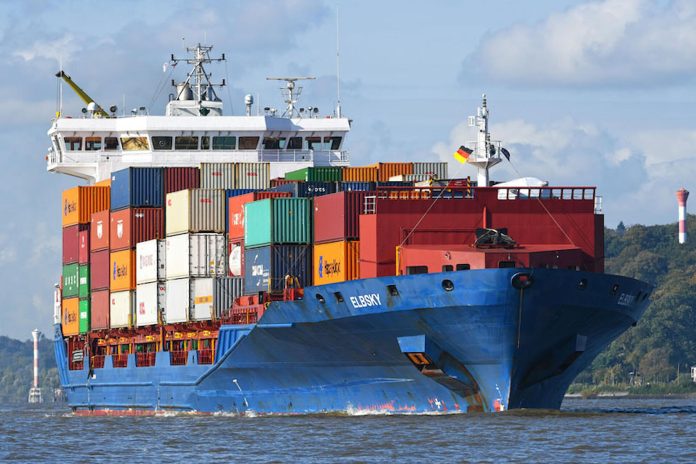
Rates on the Europe to Asia trades have mirrored headhaul trades with China’s import cargo paying more for carriage since the Red Sea crisis hit the industry in December.
At the end of last year, eastbound cargo out of European ports of origin was US$303/FEU, in January, as in the headhaul trade, rates started to climb as carriers diverted around the Cape, peaking at US$1,066/FEU on 1 February according to Xeneta, which shows rates on the slide again, now down to US$866/FEU.
“These developments on the return China Import Containerized Freight Index (CICFI) are interesting. The overall index jumped from less than 10% for the then year-to-date as per end-January to +20% one month later where it has remained,” said Dynamar analyst Darron Wadey.
According to Dynamar backhaul rates are being driven “by the separate Europe/Mediterranean trades who, as of mid-April, are 53% up, on average, compared with the start of the year, compared to North America, where the average development at the same mid-April point is only +4%.”
Critically the market shock that was felt when the Houthi Movement first attacked commercial vessels transiting the Red Sea has now subsided.
Drewry Shipping Consultants’ analyst Simon Heaney told Container News: “Panic saw rates spike at the beginning of the year in what was a kind of Covid PTSD, but then the market adjusted to the new normal and saw there was sufficient surplus capacity to cope.”
There has, however, been some confusion in the market as Linerlytica reports that “the stage for a series of larger rate hikes in May” has been set by the third straight increase in the Shanghai Container Freight Index (SCFI).
“Capacity utilisation is tightening across all main trades on stronger market demand, which will aid carriers’ GRI efforts,” said the analyst.
One Asia to Europe shipper said there had been mixed messages from the lines on the GRI’s being quoted for next Wednesday, 1 May.
“MSC is quoting a GRI from US$3,200/feu to US$4,500, and that has been followed by Maersk, whereas CMA CGM want US$4,000 and Hapag-Lloyd are reducing their 40ft rates by US$100 to US$3,100,” said the shipper.
Cargo for West and East Med destinations is also being hit with GRI’s, with MSC again leading the charge raising rates to US$5,400 and US$5,600/feu for the West and East Med respectively.
CMA CGM is offering rates slightly below MSC at US$5,200 and US$5,300 respectively while Hapag-Lloyd is again either holding or reducing rates at US$3,500 and US$3,900 respectively, to the Mediterranean.
Shippers and forwarders could be forgiven for finding this a confusing picture with Dynamar reporting the Ningbo Containerized Freight Index (NCFI), unlike the SCFI, showing a decline since the Chinese New Year.
“Rates were in slightly positive territory before the Lunar New Year but have come under pressure since then with the overall index -13% on its year-start position come mid-April,” said Dynamar analyst Darron Wadey.
“For individual trades, there were significant differences though, with Europe/Mediterranean indices averaging -23% whilst intra-Asia equivalents were +22% up, on average,” he added.
Drewry’s World Composite Index (WCI) is more in line with the NCFI, with Heaney saying that the index has been on a “12-week skid”.
“The WCI has been declining week-on-week since early February,” said Heaney, “Average rate declines were US$94/40ft in February, that accelerated to US$141/40ft in March but the rate of decline has again eased to an average of US$70/40ft this month.”
Shipbroker Braemar added that headline freight indices are not displaying a surge in spot rates right now.
“The latest surge in spot earnings, driven by Red Sea avoidance, peaked in February 2024. Since then, a gentle erosion of spot rates has been in play,” said Braemar researcher Jonathan Roach.
He noted: “We would expect freight rates to remain elevated compared to pre-Red Sea avoidance at the back end of 2023. However, with the increasing weight of the heavy newbuilding program in full force, a continued but controlled softening of spot rates is expected in the short term.”
Linerlytica said that transpacific contract rates “are settling 10-20% above last year’s levels, with the current spot rate levels pushing shippers to conclude negotiations at the higher rates.”
Drewry, drawing on data from its Shipper Benchmarking Club which allows shippers to anonymously divulge contract rates, said the market is showing a marked year-on-year decline, though Heaney cannot divulge the amounts he said they were “definitely lower”.
Mary Ann Evans
Correspondent at Large








